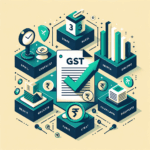Fake Billing and GST Fraud Cases 2025 – Major Crackdowns
In a startling revelation, Indian authorities have uncovered GST evasion amounting to thousands of crores, a significant portion of which is driven by the rampant use of fake invoices. This growing menace not only drains the national exchequer but also creates an unfair playing field for honest taxpayers. The government is now escalating its response, and the rising number of fake billing cases highlights a critical issue for every business owner in India. With major GST crackdowns India-wide already underway and expected to intensify into 2025, understanding this threat is no longer optional—it’s essential for survival. This article will break down what constitutes GST fraud, the serious consequences of involvement, and most importantly, provide actionable GST fraud prevention measures for businesses and individuals to protect themselves from the upcoming wave of GST fraud cases 2025. For a foundational understanding, you can also review our guide on TaxRobo’s GST Services.
What Exactly Are Fake Billing Cases Under GST?
To protect your business, you must first understand the enemy. GST fraud isn’t always a complex scheme; it often starts with a simple, fraudulent document—a fake invoice. Grasping the methods and motivations behind these scams is the first step toward building a robust defense.
Defining Fake Invoices and GST Fraud
At its core, a fake invoice is a tax invoice that has been issued without any actual supply of goods or services. The primary motive behind creating these bogus documents is to illegally claim Input Tax Credit (ITC). In a legitimate transaction, a business pays GST on its purchases (input) and collects GST on its sales (output). It can then claim a credit for the GST paid on inputs, effectively paying tax only on the value it adds. Fraudsters exploit this system by creating a paper trail of transactions that never occurred. This allows them to claim ITC they are not entitled to, which can then be used to pay their own GST liabilities or even be fraudulently encashed. The common types of fake invoices cases in India include issuing invoices from shell corporations that exist only on paper, using invoices from shut-down companies, or grossly inflating the value of goods on a real invoice to claim excess ITC.
Common Methods Used in GST Scams
Fraudsters have developed several sophisticated methods to execute these scams. Understanding their modus operandi can help you spot red flags in your own business dealings.
- Circular Trading: This involves creating a complex web of transactions between multiple shell companies. Goods (or more often, just invoices) are “sold” from one firm to another in a circular path. This artificially inflates the turnover for each entity and allows ITC to be passed along the chain without any real goods ever being supplied. The ultimate beneficiary then uses this fraudulent ITC to offset their actual GST liability on real sales.
- Shell Corporations: These are fake companies set up with the sole purpose of issuing invoices and passing on illicit ITC. They have no real business premises, no employees, and no actual trade of goods or services. They are merely paper entities designed to defraud the system.
- Identity Theft: Perhaps the most alarming method for the average person, fraudsters often steal the PAN and Aadhaar details of unsuspecting individuals. They use these stolen identities to register fake firms for GST, a process which, when done legitimately, is a crucial first step for new businesses as detailed in our guide on Launching Your Startup Right – Mastering GST Registration in India. The victim, who could be a salaried employee or a student, remains completely unaware that a company registered in their name is conducting fraudulent transactions worth crores of rupees until a massive tax demand notice arrives at their door.
The Scale of the Problem: Why the Government is Concerned
The proliferation of fake billing is not a minor issue; it’s a direct assault on India’s economy. The financial impact is staggering, with estimates of revenue loss running into tens of thousands of crores annually. This deprives the government of critical funds needed for public infrastructure, healthcare, and education. In response, agencies like the Directorate General of GST Intelligence (DGGI) have intensified their efforts, leading to a significant increase in arrests and the detection of massive fraud rings. As detailed in official releases from the Press Information Bureau on tackling GST fraud India, these crackdowns are becoming more frequent and effective, signaling a zero-tolerance policy from the government.
The Government’s Response: Major GST Crackdowns India is Witnessing
Faced with this mounting economic threat, the Indian government has moved beyond manual checks and adopted a technology-first approach to combat GST fraud. The ongoing and planned crackdowns are more sophisticated, data-driven, and collaborative than ever before, making it incredibly difficult for fraudsters to hide.
How Authorities are Tackling GST Fraud in India
The battle against fake billing cases is now being fought with algorithms and data. The GST Network (GSTN), the technological backbone of the GST regime, is at the forefront of this fight.
- Data Analytics & AI: GSTN employs advanced data analytics and Artificial Intelligence (AI) to scrutinize the massive volume of transaction data filed by millions of businesses. These systems can identify suspicious patterns, such as suppliers who generate high invoice volumes with minimal input tax credits, businesses with disproportionately high ITC claims compared to their turnover, or complex circular trading networks. These red-flagged entities are then prioritized for further investigation and physical verification.
- Special Drives: The government is conducting nationwide special drives aimed at identifying and eliminating fake registrations. These drives involve physical verification of business premises for suspicious new registrants and a thorough review of their documentation. This proactive crackdown on GST scams India-wide aims to stop fraudsters at the entry point, before they can issue a single fake invoice.
- Inter-Departmental Collaboration: The era of siloed investigations is over. The GST department now works in close coordination with the Income Tax Department, the Enforcement Directorate (ED), and other law enforcement agencies. This 360-degree approach allows for the sharing of financial data and intelligence, ensuring that fraudsters are pursued not just for tax evasion but also for money laundering and other economic offenses.
Understanding GST Fraud Consequences: Penalties and Prosecution
The consequences for getting caught in the net of these major GST crackdowns India is witnessing are severe and multi-faceted. The law provides for stringent financial penalties and even criminal prosecution, ensuring that the punishment acts as a powerful deterrent.
- Monetary Penalties: Under Section 122 of the CGST Act, 2017, any person involved in issuing fake invoices or wrongfully availing ITC is liable for a penalty of up to 100% of the tax evaded or INR 10,000, whichever is higher.
- Imprisonment: The consequences are not just financial. Section 132 of the CGST Act makes issuing fake invoices a cognizable and non-bailable offense if the tax amount involved exceeds ₹5 crore. The provision for imprisonment can extend up to 5 years, depending on the scale of the fraud.
- Other Actions: Beyond fines and jail time, authorities have other powerful tools at their disposal. They can provisionally attach the bank accounts and property of the accused to recover the government’s dues. Furthermore, the ITC claimed based on fake invoices will be blocked in the recipient’s electronic credit ledger, creating an immediate and crippling cash flow problem for the business.
Proactive Defense: GST Compliance Tips for Businesses
While the government’s crackdown is essential, the first line of defense against GST fraud begins with you, the business owner. Adopting a proactive and vigilant approach to compliance is the best way to protect your business from becoming an unwitting participant or a victim of these scams.
Step 1: Rigorous Supplier Verification
The single most important step in GST fraud prevention measures is knowing who you are doing business with. Never onboard a supplier without conducting thorough due diligence.
- Verify GSTIN: Always verify the supplier’s GST Identification Number (GSTIN) on the official GST Portal. This simple check confirms if the registration is active.
- Check Filing Status: On the portal, also check the supplier’s return filing status. A supplier who is not regularly filing their GSTR-1 and GSTR-3B is a major red flag, as you will not be able to claim ITC on their invoices.
- Physical Verification: For new or high-value transactions, consider a physical verification of the supplier’s registered place of business. Ensure they have a legitimate operational setup.
- Review Business Profile: Look into their business history, online presence, and market reputation. A genuine business will have a verifiable track record.
Step 2: Impeccable Record-Keeping
In the eyes of the tax law, if it’s not documented, it didn’t happen. Meticulous record-keeping is your best defense during scrutiny or an audit. As we’ve detailed before, there is a direct link between The Importance of Accurate Record-Keeping to Prevent GST Demand Notices and business safety. It proves the legitimacy of your transactions and your ITC claims.
- Essential Documents: Maintain a complete and organized file for every transaction, including the tax invoice, e-way bill (if applicable), delivery challan or proof of receipt of goods/services, and proof of payment (e.g., bank statements).
- Regular Reconciliation: Make it a monthly practice to reconcile your purchase records with the data appearing in your GSTR-2B (auto-drafted ITC statement). This ensures you only claim ITC for invoices that your suppliers have correctly reported to the government. This crucial step is a cornerstone of our Accounting and Bookkeeping Services.
More GST Fraud Prevention Measures
- Avoid Large Cash Transactions: For B2B supplies, always use formal banking channels for payments. Large cash transactions are a red flag for tax authorities and make it difficult to prove the legitimacy of a transaction.
- Beware of “Too Good to be True” Deals: Be extremely cautious of suppliers offering goods at unusually low prices while still providing a full GST invoice. This is a common tactic used by fake billers to lure legitimate businesses.
- Educate Your Team: Ensure your accounting and procurement staff are well-trained on GST compliance, the risks of fake invoices, and the importance of supplier due diligence.
A Warning for Salaried Individuals: How You Can Be a Victim
The threat of GST fraud is not limited to business owners. Salaried individuals are increasingly becoming victims of identity theft, with severe consequences.
The Identity Theft Risk
Fraudsters actively hunt for KYC documents of unsuspecting individuals. They might obtain your PAN card, Aadhaar card, and an electricity bill through fake job offers, rental agreements, or loan scams. With these documents, they can register a shell company for GST in your name without your knowledge. This fake company is then used to generate crores in fake invoices. You, the victim, remain completely oblivious until a notice from the GST department arrives, holding you liable for the massive tax fraud committed in your name.
Red Flags and Protective Measures
Protecting your identity is paramount. Be vigilant and take these simple steps to safeguard yourself.
- Red Flags: Be wary of unsolicited calls or messages offering easy money in exchange for your documents or OTPs. Be suspicious of unexpected credit alerts in your name or tax notices for businesses you don’t recognize.
- Protective Measures:
- Never share your PAN, Aadhaar, bank details, or OTPs with unknown or untrusted persons or entities.
- Periodically check your Form 26AS on the income tax portal. This form reflects all high-value transactions linked to your PAN and can help you spot any suspicious activity early.
- When sharing documents for legitimate purposes like job applications, consider watermarking them with the purpose (e.g., “For ABC Company Job Application Only”).
Conclusion
The government’s message is loud and clear: the era of lax enforcement is over. The commitment to eradicating tax evasion through major GST crackdowns India is implementing will only intensify as we head into 2025. For businesses, the risks associated with fake billing cases—from crippling financial penalties to imprisonment—are too high to ignore. The only sustainable path forward is one of unwavering compliance and extreme vigilance. By diligently verifying suppliers, maintaining impeccable records, and fostering a culture of compliance, you can build a fortress around your business. Remember, in the world of GST, ignorance is not a defense. Proactive compliance is the best shield against getting entangled in the complexities of GST fraud cases 2025.
Navigating GST compliance can be complex and risky. Don’t leave your business exposed. Contact TaxRobo’s expert team today for a comprehensive GST health check and ensure you are fully compliant and protected.
Frequently Asked Questions (FAQ) Section
Q1: What is the penalty for being involved in fake invoice cases in India?
A: The penalties are severe and can cripple a business. They include a monetary fine equivalent to 100% of the tax evaded or INR 10,000 (whichever is higher). More seriously, for fraud involving amounts over ₹5 crore, it can lead to imprisonment for up to 5 years, as it is treated as a cognizable and non-bailable offense.
Q2: How can I verify if a supplier’s GSTIN is genuine?
A: You can and should verify every new supplier’s GSTIN on the official Government GST Portal. Simply visit `https://www.gst.gov.in/`, navigate to “Search Taxpayer,” and choose “Search by GSTIN/UIN.” This will show you the legal name of the business, registration date, and most importantly, their return filing status.
Q3: What should I do if I receive a GST notice for a company I don’t own?
A: Do not ignore it under any circumstances. This is a classic sign of identity theft. You must act immediately. Contact a tax professional or lawyer, file a formal police complaint (specifically with the cybercrime division), and immediately write to the concerned GST department, informing them of the identity theft and lodging your objection.
Q4: Can I claim Input Tax Credit (ITC) from a supplier who doesn’t file their GST returns?
A: No. A critical condition for you to be eligible to claim ITC is that your supplier must have filed their outward supply details in their GSTR-1, and this must be reflected in your GSTR-2B. Furthermore, the supplier must have paid the corresponding taxes to the government. These rules are governed by Section 16 of the CGST Act: Conditions and Time Limits for Availing ITC. If your supplier defaults, your ITC can be denied, which is why continuous monitoring of supplier compliance is crucial.



